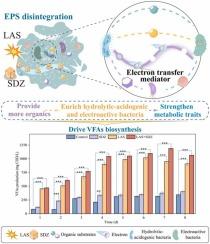Overlooked roles of improved substrates functions in remodeling microbial community and driving metabolic traits during sludge fermentation triggered by surfactants and antibiotics co-existence
IF 12.2
1区 环境科学与生态学
Q1 ENGINEERING, ENVIRONMENTAL
引用次数: 0
Abstract
Sludge anaerobic fermentation is a pivotal route to transit wastewater treatment plants towards energy-neutral and resource recovery-oriented plants, while the overall efficiency is commonly restrained by co-exist contaminants. This study unveiled the cooperative effect of sulfadiazine (SDZ) and linear alkylbenzene sulfonates (LAS) in driving volatile fatty acids (VFAs) biosynthesis during waste activated sludge (WAS) anaerobic fermentation. The VFAs remarkably elevated to 1189 mg COD/L in LAS/SDZ, which was approximately 1.3–3.2 folds of SDZ and LAS. SDZ and LAS synergistically disintegrated extracellular polymeric substances to provide fermentation substrates. These changes altered microbial population and enhanced microbial networks interconnection. Moreover, the proteins released from WAS might facilitate electron transfer among microorganisms. The functional anaerobic species, including hydrolytic-acidogenic bacteria (e.g., Veillonellaceae and Lactobacillus) and electroactive bacteria (e.g., Parabacteroides and Fonticella), were enriched. Also, the metabolic traits responsible for transmembrane transport, intracellular metabolism, VFAs biosynthesis and electron transfer-related process were strengthened with the upregulation of functional genes. Further analysis revealed that the functional anaerobic species activated quorum sensing and two-component systems to counteract unfavorable LAS/SDZ stress and maintain high metabolic activities. This work elucidated the overlooked roles of substrates in modulating anaerobic consortia and metabolic traits in sludge fermentation systems with mixed pollutants stressing.

表面活性剂和抗生素共存引发的污泥发酵过程中,被忽视的底物改良功能在重塑微生物群落和驱动代谢特征方面的作用
污泥厌氧发酵是污水处理厂向能源中性和资源回收型工厂转型的关键途径,但其整体效率通常受到并存污染物的制约。本研究揭示了磺胺嘧啶(SDZ)和线性烷基苯磺酸盐(LAS)在废物活性污泥(WAS)厌氧发酵过程中对挥发性脂肪酸(VFAs)生物合成的协同作用。在 LAS/SDZ 中,挥发性脂肪酸显著升高至 1189 mg COD/L,约为 SDZ 和 LAS 的 1.3-3.2 倍。SDZ 和 LAS 协同分解了细胞外的高分子物质,为发酵提供了基质。这些变化改变了微生物种群,加强了微生物网络的相互联系。此外,从 WAS 中释放的蛋白质可能会促进微生物之间的电子传递。功能性厌氧物种,包括水解产酸菌(如 Veillonellaceae 和 Lactobacillus)和电活性菌(如 Parabacteroides 和 Fonticella)得到了丰富。此外,随着功能基因的上调,负责跨膜运输、细胞内代谢、VFAs 生物合成和电子传递相关过程的代谢特征也得到了加强。进一步的分析表明,功能性厌氧物种激活了法定量感应和双组分系统,以抵消不利的 LAS/SDZ 压力,并维持高代谢活性。这项工作阐明了底物在混合污染物胁迫下的污泥发酵系统中调节厌氧菌群和代谢特征的作用。
本文章由计算机程序翻译,如有差异,请以英文原文为准。
求助全文
约1分钟内获得全文
求助全文
来源期刊

Journal of Hazardous Materials
工程技术-工程:环境
CiteScore
25.40
自引率
5.90%
发文量
3059
审稿时长
58 days
期刊介绍:
The Journal of Hazardous Materials serves as a global platform for promoting cutting-edge research in the field of Environmental Science and Engineering. Our publication features a wide range of articles, including full-length research papers, review articles, and perspectives, with the aim of enhancing our understanding of the dangers and risks associated with various materials concerning public health and the environment. It is important to note that the term "environmental contaminants" refers specifically to substances that pose hazardous effects through contamination, while excluding those that do not have such impacts on the environment or human health. Moreover, we emphasize the distinction between wastes and hazardous materials in order to provide further clarity on the scope of the journal. We have a keen interest in exploring specific compounds and microbial agents that have adverse effects on the environment.
 求助内容:
求助内容: 应助结果提醒方式:
应助结果提醒方式:


